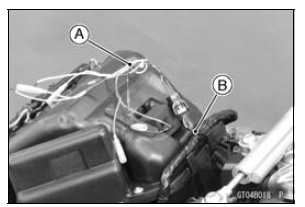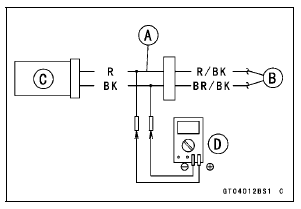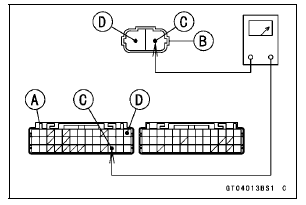

NOTE
Be sure the battery is fully charged.
Main Harness [B] Intake Air Temperature Sensor [C]
Special Tool - Measuring Adapter: 57001-1700


Intake Air Temperature Sensor Output Voltage Connections to Adapter: Digital Meter (+) → R (sensor R/BK) lead Digital Meter (–) → BK (sensor BR/BK) lead
Output Voltage Standard: About DC 2.44 ∼ 2.69 V at 25°C (77°F)
NOTE
The output voltage changes according to the intake air temperature.
If the reading is within the standard, check the ECU for its ground, and power supply (see ECU Power Supply Inspection in the Fuel System (DFI) chapter).
If the ground and power supply are good, replace the ECU (see ECU Removal/Installation in the Fuel System (DFI) chapter).
If the reading is out of the standard, remove the ECU and check the wiring for continuity between main harness connectors.
Special Tool - Hand Tester: 57001-1394

Disconnect the ECU and sensor connectors.
Wiring Inspection ECU Connector [A] ←→ Intake Air Temperature Sensor Connector [B] R/BK lead (ECU terminal 37) [C] BR/BK lead (ECU terminal 13) [D]
If the wiring is good, check the intake air temperature sensor resistance (see Intake Air Temperature Sensor Resistance Inspection).
 Intake Air Temperature Sensor Installation
Intake Air Temperature Sensor Installation Intake Air Temperature Sensor Resistance Inspection
Intake Air Temperature Sensor Resistance InspectionCheck 3-5: Warning Indicator Light (Red LED) (Oil Pressure Warning)
Inspection
Connect the leads in the same circuit as Check 3-2.
Connect the terminal [10] to the battery (–) terminal.
Check that the oil pressure warning symbol [A] and the
warning indicator light (Red LED) [B] go on.
If the indicator light does not go on, replace the meter unit.
...
Exhaust Butterfly Valve Actuator Installation
Install the pulley [A] on the actuator so that the hole side
[B] align with the groove [C] on the shaft.
Make sure that the groove on the shaft is pointing toward
the center of the screw [D].
If the shaft position is incorrect, refer to the following
NOTE and procedures to electrically ad ...
Crankcase Splitting
Remove the engine (see Engine Removal in the Engine
Removal/Installation chapter).
Set the engine on a clean surface and hold the engine
steady while parts are being removed.
Remove:
Cylinder Head (see Cylinder Head Removal in the Engine
Top End chapter)
Starter Motor (see Starter M ...